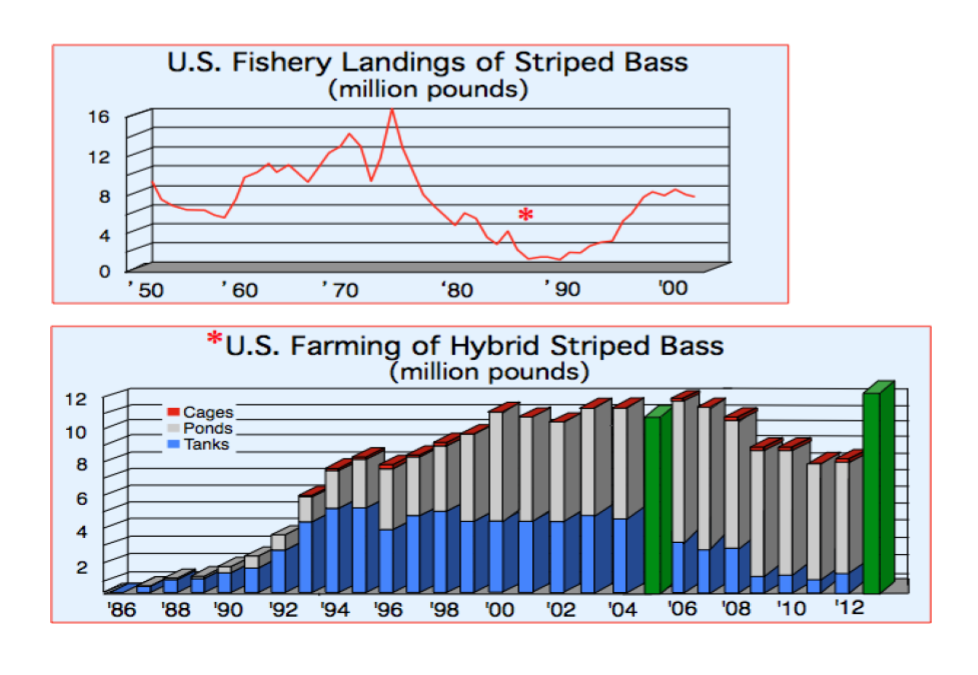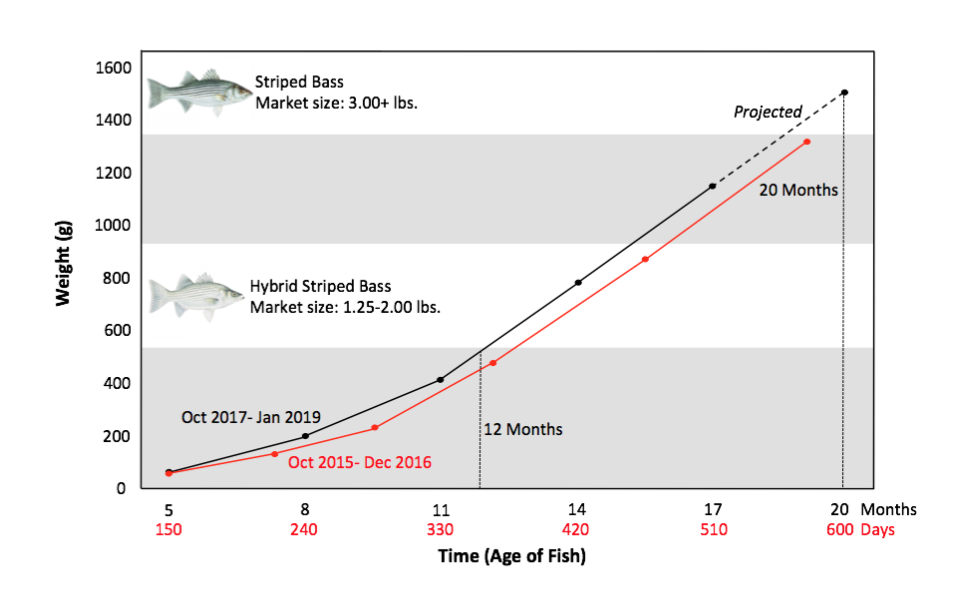History
History and Current Status of the U.S. Striped Bass Fishery

Census.
Striped bass are one of the most popular fishes of the North American Atlantic coast and its economic importance dates to colonial times. At the beginning of the 20th century, the U.S. Fish and Fisheries Commission (USFWS) published effective techniques for spawning, hatching, and releasing striped bass.
Overfishing and habitat degradation contributed to the collapse of the striped bass fishery in the 1980s. This opened the path to commercial hybrid striped bass aquaculture that began in North Carolina to supply a replacement product during the striped bass moratorium of the 20th Century (Maryland 1985-90; Virginia 1989-90) (Figure 1). Development of the hybrid striped bass aquaculture industry was pioneered by Ronald Hodson (NC State, NOAA NC Sea Grant) and Reginald Harrell (University of Maryland, USDA Northeastern Regional Aquaculture Center) among others and the industry has grown to over 12 million lbs per year with a farm gate value of $50 million.
Recent recreational landings along the Atlantic coast were about 25 million lbs per year from 2007 to 2014 and commercial striped bass harvest grew from 3.4 million lbs in 1995 to 6 million lbs in 2002.1 Commercial landings averaged about 7 million pounds annually from 2003 to 2014 and the commercial quota was reduced to approximately 5.0 million lbs in 2017.
Atlantic striped bass stocks are managed by eastern coastal states, but despite efforts to reduce harvest levels, the stocks continue to decline and are now overfished, according to a 2019 assessment presented to The Atlantic States Marine Fisheries Commission. In 2019, the North Carolina Division of Marine Fisheries closed the striped bass fishery in the Central/Southern Management Area due to the decline.
The Opportunity for Striped Bass Aquaculture
Environmentally conscious striped bass aquaculture can promote economic development of inland as well as coastal communities and provide a supply of readily available seafood to supplement the declining commercial wild-harvest striped bass fishery. The present-day economic and environmental scenario is very similar to the striped bass fishery decline and moratorium of the 1980s that led to the development of hybrid striped bass aquaculture, which has since grown to be a major U.S. aquaculture industry.2, 3
Recent evidence from seafood markets along the mid-Atlantic region indicates a high demand for marine finfish with a desired size of 3 to 5 lbs.4 Currently, this demand cannot be met by hybrid striped bass, whose growth and feed efficiency rapidly decline at 1.5 lbs in size.5 Due to the superior growth characteristics of striped bass (Figure 3), it is better suited to meet the market demand for larger-sized fish over its hybrid counterpart.

The declining US wild striped bass fishery landings from 2008 to 2017 and its increasing value show that there is a strong potential market value for aquacultured striped bass. An underutilized current annual market of about 2.5 million pounds of striped bass appears available along the Eastern Coast of the US that cannot be filled by the declining commercial fishery.
Striped Bass Culture Technology
Considerable research on aquaculture of striped bass and its hybrids has been conducted and entire books and culture manuals have been published. In addition, many studies focusing on nutrition and feeds, pond fingerling production, pond and RAS culture methodologies and management practices, stress mitigation, and high salinity tolerance have been published. The wealth of studies that have been conducted on striped bass has allowed for the development of a captive-bred, domesticated broodstock.
Striped bass are a popular fish along the Eastern and West Coasts of the U.S. and can be successfully cultured using established methods. It has a high likelihood of commercial success due to its visibility to consumers, market size, price point, and existing infrastructure for production. It can be raised in fresh, brackish, or marine water in various systems throughout the country, making it well-positioned for development and expansion in the U.S.
References
- 1 www.st.nmnfs.noaa.gov
- 2 Hodson, R.G., 1990. Hybrid Striped Bass Biology and Life History. Leaflet/Texas Agricultural Extension Service; no. 2416.
- 3 Hodson, R.G. and Hayes, M., 1990. Hybrid Striped Bass Pond Production of Foodfish. Leaflet/Texas Agricultural Extension Service; no. 2411.
- 4 Locals Seafood and data from current retail markets
- 5 Harrell, R.M. 1997 (Ed.). Striped bass and other Morone culture. Elsevier Science B.V., Amsterdam, The Netherlands.